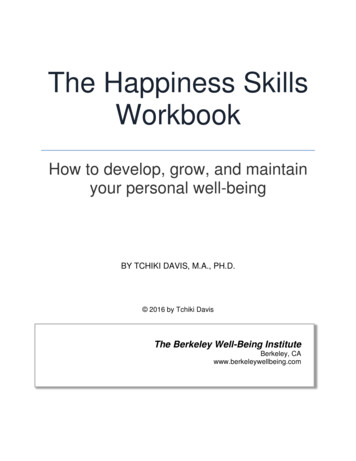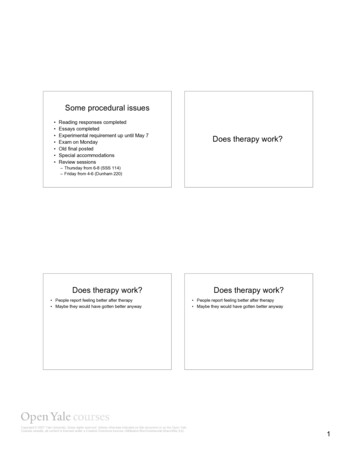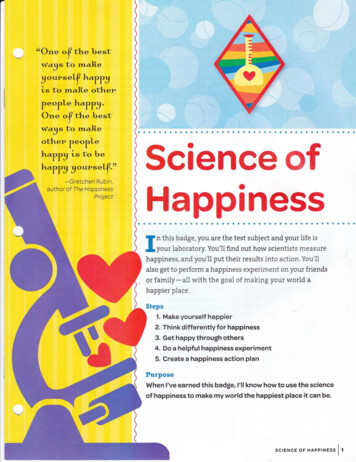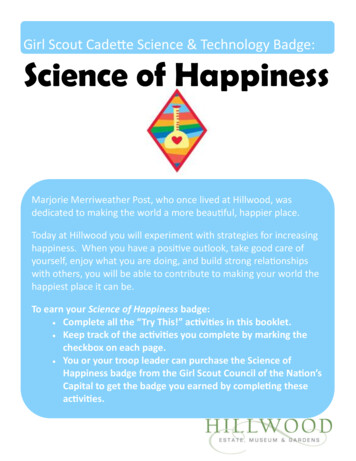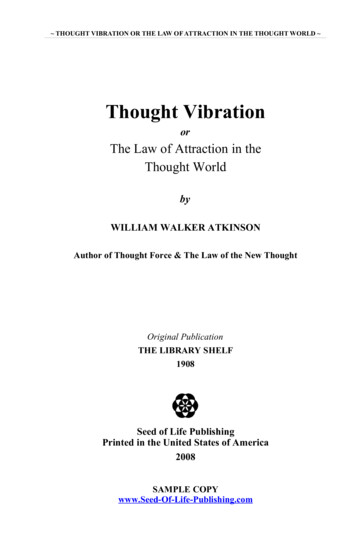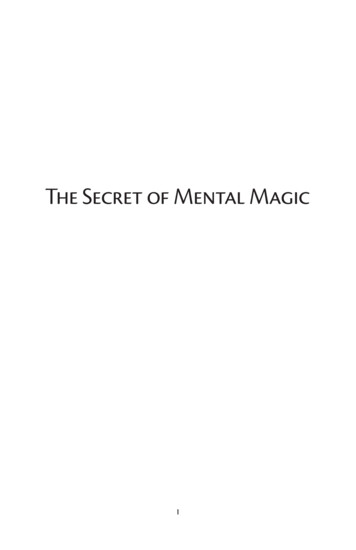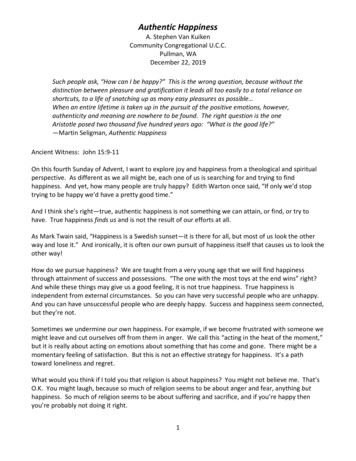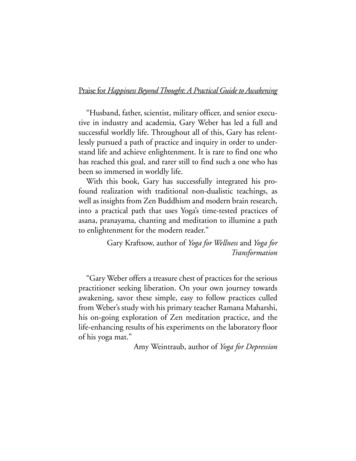
Transcription
Praise for Happiness Beyond Thought: A Practical Guide to Awakening“Husband, father, scientist, military officer, and senior executive in industry and academia, Gary Weber has led a full andsuccessful worldly life. Throughout all of this, Gary has relentlessly pursued a path of practice and inquiry in order to understand life and achieve enlightenment. It is rare to find one whohas reached this goal, and rarer still to find such a one who hasbeen so immersed in worldly life.With this book, Gary has successfully integrated his profound realization with traditional non-dualistic teachings, aswell as insights from Zen Buddhism and modern brain research,into a practical path that uses Yoga’s time-tested practices ofasana, pranayama, chanting and meditation to illumine a pathto enlightenment for the modern reader.”Gary Kraftsow, author of Yoga for Wellness and Yoga forTransformation“Gary Weber offers a treasure chest of practices for the seriouspractitioner seeking liberation. On your own journey towardsawakening, savor these simple, easy to follow practices culledfrom Weber’s study with his primary teacher Ramana Maharshi,his on-going exploration of Zen meditation practice, and thelife-enhancing results of his experiments on the laboratory floorof his yoga mat.”Amy Weintraub, author of Yoga for Depression
“I’ve had the wonderful privilege of experiencing Gary inaction over many years both as friend and teacher. Gary is therare gem who points directly to what we really are at the heart ofour being—timeless Presence—ever-present Stillness that isalways immediately available; yet which we fail to recognizebecause of our over-identification with the changing circumstances of our lives. Gary offers us a fresh view, based on hisfirsthand experience of the paradox of enlightenment: thatwhile there is nothing we can ultimately do to awaken to ourtimeless Presence, there are exquisite perennial practices of ‘nondoing’ that prepare the ground and clear the way for awakening.Gary beckons us to awaken from our dream of separation andrealize our timeless and non-separate oneness with everything.Few may take up his call, but no pointer is more needed thanhis to call for us to come home.”Richard Miller, PhD author of Yoga Nidra: The MeditativeHeart of Yoga“If you’re interested in understanding the many levels of spiritual reality, or the secrets uncovered in a cave in the Himalayas,or what adventures lie in store for you after you die, then GaryWeber’s book is definitely not for you. There’s no metaphysicalspeculation here, no religiosity, and no mystification. Instead, asits title points out, this is a practical guide. It’s as close as theycome to a “How To” manual, not only for getting enlightened,but also for what to expect when you’re there.”James Lough, Ph.D., Editor of Sites of Insight: A Guide toColorado Sacred Places
HAPPINESSBeyond Thought
HAPPINESSBeyond ThoughtA Practical Guide to AwakeningGary Weber, Ph. D.iUniverse, Inc.New York Lincoln Shanghai
Happiness Beyond ThoughtA Practical Guide to AwakeningCopyright 2007 by Gary WeberAll rights reserved. No part of this book may be used or reproduced by anymeans, graphic, electronic, or mechanical, including photocopying, recording,taping or by any information storage retrieval system without the writtenpermission of the publisher except in the case of brief quotations embodied incritical articles and reviews.iUniverse books may be ordered through booksellers or by contacting:iUniverse2021 Pine Lake Road, Suite 100Lincoln, NE 68512www.iuniverse.com1-800-Authors (1-800-288-4677)You should not undertake any exercise regimen recommended in this bookbefore consulting your personal physician. Neither the author nor the publishershall be responsible or liable for any loss or damage allegedly arising as aconsequence of your use or application of any information or suggestionscontained in this book.ISBN-13: 978-0-595-41856-5 (pbk)ISBN-13: 978-0-595-86201-6 (ebk)ISBN-10: 0-595-41856-2 (pbk)ISBN-10: 0-595-86201-2 (ebk)Printed in the United States of America
Dedicated to Ramana Maharshi who found melost and wandering in a dark forest, taught mewhat inquiry, love, and surrender were andbrought nobody home
AcknowledgementsMy deepest appreciation for the kindness of Sri V. S. Ramanan, President of SriRamanasramam (Ramana Maharshi’s ashram in Tiruvannamalai, South India)for his permission to use Ramana’s teachings and photograph, without which thisbook could not have taken shape.I would also like to extend my thanks to Russill Paul for permission to drawfrom his work on Vedic chanting and chant arrangements and to David Godmanfor permission to quote from his book on Annamalai Swami.My deep gratitude for the many hours and years I have shared with so manywonderful teachers and fellow travelers. Although too numerous to mention,those who had particular impact were Toni Packer, Roshi Eido Shimano, J.Krishnamurti, Swami Rama, Amrit Desai, Adyashanti, Gangaji, Poonjaji, SwamiChetanananda, Swami Viditatmananda and of course my Sat Guru, RamanaMaharshi. No words would ever be enough.A special thanks to Gary Kraftsow and Richard Miller. I spent much time witheach of them over many years as friend and fellow spiritual traveler.Thanks to those who read, commented on, and dramatically improved themanuscript over its long inception, particularly James Lough, Richard Miller,Amy Weintraub, Gary Kraftsow, Stephan Bodian, Joan Ruvinsky, my daughterPaige, and last, but far from least, my wife, Jeanne. Thanks to Ralph Moon forassistance with the translation of Nirvana Shatakam.I give many thanks for/to “my students.” They are the voice of the Universe asking itself questions to which it already knows the answers, yet it still finds delight inthe beautiful mysterious dance.A majority of any author profits from this book will be donated to supportwork with disabled children in southern India.The author can be contacted at non dual awakening@earthlink.net.-ix-
ContentsIntroduction .xiiiPractices .1A. Some exercises for understanding your mind and thoughts .1B. The Case for Practice in Awakening .12C. How do you use physical postures (asanas) for awakening? .17D. How should you sit for breathing, chanting and meditation? .27E. How can you use the breath to awaken? .30F. How can you use chanting to awaken? .35G. Meditative Inquiry—Where the rubber meets the road .41H. Negations—How can saying you’re not something be useful? .47I. Using Affirmations .53J. Surrender—Is it possible? Is it necessary? .56K. Does it matter what you eat? .66L. Chakras .68M. Is there one simple practice to tie this all together? .69N. What will awakening/Self-realization/enlightenment be like? .70The Teachings .73A. Upadesa Saram—The Essence of the Teachingsof Ramana Maharshi .74B. Nirvana Shatakam—Six Verses on The State of Enlightenment,Freedom and Happiness by Shankara .109C. The Bhagavad Gita—Selected Verses .119-xi-
xiiHappiness Beyond ThoughtQuestions and concerns raised in dialogue .125Biography .143References .147Bibliography .149Other Useful Sources for Further Work .153
Introduction“A veil was lifted. All of a sudden there was recognition that I’m not my thoughts.Everyone always says it but I never felt it. It turns out I’m actually not the voice inmy “head” that says stuff. That’s separate from me. Immediately after was therecognition “I am awareness” I really am ad hoc. Thoughts occur, feelingsoccur, body occurs (physical sensations), I witness. It’s so big, though, the feel.I am AWARENESS, not just I am aware. That’s big Better: awareness isaware. it’s less personal than me. and regardless of what I want, what is isand what will happen will happen.”This e-mail from a student of mine captures what awakening is. It is the clearrecognition that we aren’t our thoughts or the stories that we tell ourselves. Wearen’t the bodies that we worry about so much. We aren’t the sensations that wecrave and fear. We are the already present happiness, the still awareness beyondthought within which all of this occurs. That awareness is beyond fear, beyondsuffering, beyond death itself.This book offers a direct practical approach to having that recognition unfold.It uses practices from yoga, Zen meditation, and Eastern philosophies in a synergistic, holistic way. Although these practices are powerful by themselves, the oddsof your awakening increase significantly through using them together. You can dothese practices, as I did, while living a full, active, engaged life in today’s worldincluding working and having a family. You don’t need to retire to a cave, changeyour name, leave your family, stop working, change your hairdo, go to India, orget a new wardrobe. You do not need to surrender your money and possessions tosome colorfully-dressed and impressively-titled keepers of secret knowledge andpractices.The best news of all is that the truth of who you really are isn’t outside you noris it some experience that you have to struggle to replicate. Your ultimate reality,your enlightened state, is already pre-installed. You come right from the factorywith the software already downloaded and running. All that you have to do is tounderstand what is blocking you from seeing it and to realize that it has alwaysbeen there. With that, you will see that it is what you are.-xiii-
xivHappiness Beyond ThoughtThe direct approach to awakening into the happiness that you already are isnot to gather more knowledge or experiences, but to recognize and remove theresidue from the ones that you have already had. A helpful metaphor can be onefrom the ancient Egyptians.Scales of JudgmentThis image depicts the scales of judgment that the Egyptians believed wereused to measure one’s worthiness to go to their equivalent of heaven. The recentlydeceased folk would go to the underworld and be led to these scales. On the leftside would be placed the deceased’s heart; a feather was placed on the right side.If the deceased’s heart was heavier than a feather, a ferocious demon immediatelydevoured the heart and the folk. If the heart was lighter than a feather, eternalbliss and happiness followed.We will go through many approaches in this work, all with the purpose of(en)lightening your heart by clearing away the confusion, conditioning and thoughtthat hide your natural reality. We will not be adding yet more knowledge and confusion which would only make your metaphorical heart heavier. We will draw uponyoga, Zen meditation and Eastern philosophy in this lightening operation.Traditional yoga as normally practiced now in the West with its focus onachieving certain postures (asanas) and bodily perfection naturally leads to comparisons and conflicts. Very few yoga classes involve any type of meditation ormeaningful investigation of mind or consciousness. Even fewer courses offer any
G a r y We b e r, P h . D .xvinsight into what is really achievable through yoga beyond a few catch phrases oreven how to use asanas for awakening from the dream that we are.In a typical course, an ad hoc practitioner of yoga is created who is subsequently enhanced, measured and critiqued; this does not lead to a lightenedheart. What results is more confusion and anxiety and yet another new troubledand complex persona. This is a step backwards, even if the practices are elegantand esoteric and lead to fascinating party conversation with new and interestingpeople and special clothes and gear. I say this as someone who has done well over10,000 hours of asanas in over 35 years of practice with many different teachersin many different schools.Zen meditation is focused on meditation techniques, often in a highly-structured format intended to produce awakening/enlightenment. However, whatmore often results is a doer with nifty badges, names, clothes and titles who haslearned many elegant practices. The result can be a disciplined and focused mind,some temporary relief of stress, possibly intermittent stopping of thoughts andsome passing spiritual experiences. What seldom results is a transformation inconsciousness so that you become your natural state of stillness and happiness.Most meditation practices also do not incorporate a physical practice donewith much understanding. Without this, there is little possibility of activatingand addressing deeply-held conditioning, memories or fears that may be lockedin your physiological structure. This is a great opportunity missed as the bodyknows on a cellular level the real truth that we are.These comments arise from a meditation practice that has spanned over threedecades and over 13,000 hours with several of the best known teachers, Zen andotherwise, including being passed on the level of understanding.Eastern philosophies, including Hindu, Buddhist, Taoist and Sufi approaches,are sophisticated and elegant. They can provide, particularly for the Westernmind, powerful new tools to deconstruct or reconstruct the heavily-conditionedmind into a more holistic model and potentially even to transcend it completely.Unfortunately, what often results is yet another religion with rigidified beliefs,certainties and practices far from the understanding of its founder(s). It does,however, provide many opportunities for new, exciting and endless philosophicaldiscussions. Philosophy can be a great ally on the path to awakening, but it can bea terrible master.In this book, many different practices will be presented that draw upon thestrengths of these approaches. They will be merged in a constructive and practicalway. The focus will be on using them to produce a deep questioning of thenature, structure and functioning of the mind and the ego/I. Doing this questioning with a strong desire for the truth can result in a deep understandingwhich weakens the hold of thoughts and the I. This can open the way to realizing
xviHappiness Beyond Thoughtthe already existing happiness that you naturally are that is there beyond the operation of thought.Most languages are constructed around a subject who does something with anobject. We call that subject “I”. You can ultimately discover that the “I” is notreal. However, it is virtually impossible to find something to put in its place linguistically that will not be hard to understand, clumsy and obtuse. Differentapproaches like using the third person, substituting a lower case “i”, trying not touse a subject, writing in some passive voice, etc. were all tried. They were universally rejected by readers, editors, and reviewers. So an “I” will be used in thisbook, even though it is fictitious, in the interest of readability. There are someaboriginal tongues that supposedly don’t have a subject, but since neither you norI know them, we will have to make do with English as it is. It will be kind of likeknowing that the Thames River in London is pronounced “temz”. It’ll just be ourlittle secret.There will be much discussion of non-duality, also known as “advaita” inSanskrit from “a”—not and “dvaita”—two. These terms simply mean that everything is really one thing even though it appears to be a bunch of subjects andobjects. It also logically follows that you, as a separate entity, don’t exist in the waythat you think you do. It is a “bad news, good news” story; the bad news is thatyou don’t exist (actually it isn’t that bad), the good news is that you’re everything.Not a bad trade.We will start with some simple exercises to look at the nature of thought, howit functions and what our (mis)conceptions are of mind and thought. You will seechapters in the Practice section dedicated to utilizing yogic approaches like postures (asanas), breathing (pranayama), and chanting for awakening. There areeven a few words on diet and chakras. There are also chapters focused on Self realization through meditation, inquiry, the use of affirmations and negations, andsurrender, one of the most misunderstood topics.The Text section draws upon three of the most powerful texts for awakening.One is about 80 years old, another 1200 years old, and the third approximately2500 years old. Each text is given in the Sanskrit in which it was written. It isthen translated, explained and commented on, perhaps with a poem. It is notnecessary to learn the Sanskrit. You will not be more enlightened if you learn theSanskrit version. It will appeal to some; others will avoid it like the plague like Idid, originally.All of these texts and practices have been used in classes or workshops with realfolk just like you. The format throughout is questions and answers as that wasmost effective and useful in my personal practice and in working with others.
G a r y We b e r, P h . D .xviiThere is nothing here that is beyond you. It is hopefully as practical, simple andnatural as it can be, as is awakening itself.It is not intended that you will do every practice or study every text in theorder presented or even at all. Some will catch your interest immediately, otherswill be of no interest whatsoever at the present time, or perhaps ever. As you gothrough the book, the practices and lines of text that are yours will grab you andhold you—go with them as far as they take you. When they have lost their hold,they have done their job and it is time for you to move on to another. Once theboat has taken you across the river, leave it on the bank. Don’t keep trying tomake it work again just because it worked before.You may have heard that you are already enlightened and perfect and thatthere is nothing that you need to do. You may have also read that there is no youand that everything is beyond your control, so doing a practice is impossible.However, if just hearing those statements were enough, you and the millions whohave heard them would already be enjoying endless uncaused stillness and peace.If you are, you don’t need this book. If that isn’t your reality, you will need to dosome work. This book, which has come from nowhere and is written by no one,will give you approaches that can make that realization yours and the ever presentmysterious reality and happiness that you are apparent. Let’s get to it.
PracticesA. Some exercises for understanding your mind and thoughtsLet’s begin by seeing what the nature of thought is and how it functionsthrough doing some simple exercises. If you are going to move beyond thought,you at least need to understand the type of challenge that you face.A helpful approach is to investigate the I as if it was applying for a job, realizing of course that you are both the interviewer and the applicant. What are yourexpectations that the I needs to fulfill it is it to be successful in this job? Typicalworkshop lists when I have asked this include “protect me from harm”, “makegood choices”, “remember what is important”, “be there only when needed”,“remember only good experiences”, “don’t obsess about the past”, “make mehappy”, “know what’s going to happen to me”, etc. As you work your waythrough the exercises which follow, see if the I in which so much is invested iscapable of delivering on these expectations and what an I actually is.Several different approaches to this much misunderstood, but omnipresenttopic of thought can be helpful. Drawing a few insights, which may surpriseyou, from Ramana Maharshi’s Upadesa Saram discussed in more detail in theTexts section:17. If you search for your mind, you will find that it doesn’t exist.8. Instead of meditating on an object, know that you are That, the One.19. See where the I comes from and it will disappear.Using this guidance, let’s first explore the nature of our minds.-1-
2Happiness Beyond ThoughtWhat types of thoughts do you have?First, focus on the types of thoughts that you have. Sitting quietly, watch thebreath until it becomes slower and calmer so that separate thoughts or shortthought streams on one subject can be identified. Begin placing thoughts intothree buckets. If thoughts were real, you could use external buckets, but sincethoughts are not real, you will have to make do with internal buckets, which arealso only thoughts.The first bucket is for thoughts about the past: pains, pleasures, regrets, joys,“shudas,” “cudas,” etc. The second bucket is filled with thoughts about the present: what is NOW, right this instant. The third bucket is filled with thoughtsabout the future: plans, fantasies, fears of failures or pains, hoped for successesand pleasures, “I’m going to tell her when I see her,” etc.Do not count sensations without thoughts, characterization or classificationattached to them. These are the present. If a sensation is followed by recognition,naming, categorization, analysis, memory, and a story or something to be doneabout it, that’s not NOW. The pure sensation is gone and thought has arrived onthe scene with an experiencer, or a doer who is going to do something about it.For example, if you hear a car passing it can be just sound, just the pure soundbeing received by an open, clear and aware receptor-hearing without a hearer orsomething that is heard. If the sound becomes a car, then a car outside, then a caroutside making too much noise, then a car outside making too much noise thatsomeone needs to do something about, then that isn’t in the present.Fill your buckets for about 5 minutes. At the end of five minutes, look at yourbuckets and see what has happened. Which of the buckets shown in the graphicbelow are full, or nearly full, for you? Are any buckets virtually empty? What doesthis tell you about your thoughts?
G a r y We b e r, P h . D .3Most folk spend virtually all of their lives in their thoughts, in the past andfuture. You are almost never in the mystery and wonder of what is really unfolding just as it is, NOW. When you are eating, you are thinking about work. Whenyou are at work, you are dreaming of seeing your friends at a party. When you areat the party with your friends, you are thinking about talking to someone else,what you’re going to say next, what you just said that was wrong or brilliant, orbeing at a better party.Recognizing that you live a second-hand life can be an important realization.Seeing that thoughts rob you of your life, of your inherent happiness and awarenesscan open the way to letting go of them. Can you see that this fascination and fixationwith your thoughts means that you are always somewhere else in some other time?Why are you afraid to be here, in this present, right NOW? Don’t let your life be likethe John Lennon quote, “what happens to you while you’re making other plans.”What is the path of your thinking? Do your thought streams follow a pattern?Sitting still and quiet, with a piece of paper and something to write with, tracethe flow of your thought streams. As a stream of thoughts about one topic starts,draw a straight line and continue with that line until another thought stream onanother topic takes over and interrupts the first. With this shift, draw the line inanother direction until that thought stream is interrupted by another. Continuefor three to five minutes.What was your experience? Is your thinking a long, continuous stream ofthoughts about one topic, or is it random, even chaotic, with many short streamson many unrelated topics? Which of the patterns shown below was most likeyours? Were your surprised at the outcome?
4Happiness Beyond ThoughtAs many times as I have done this in workshops and classes, no one has everdrawn a straight line; most draw something like the bottom line. Folk are surprised by this outcome. They can’t believe that is how it really is. We like tobelieve that our thoughts are some continuous sequence of rational considerations and conclusions that we control. Is that what your thoughts are? Are you incontrol of your thinking process? Are you making the decisions to start the nextstream of thoughts and which subject will be next? Is this process in control orout of control? If you believe your thoughts are who you are, what does this tellyou? Who’s driving this bus?How often is “I, me, mine” part of a thought?From a centered, calm, still space, mentally construct two new buckets intowhich you will place your thoughts. It may be helpful to go back to your breathfor several minutes and focus on your exhales and inhales before beginning. Thefirst bucket will contain those thoughts that have an “I,” “me,” or “my” in them.The “I,” “me,” “my,” may be explicit or implied, obvious or slightly hidden somewhere. The second bucket will have those thoughts that do not have an “I,” “me,”or “my” in them.At the end of five minutes, see what is in the two buckets. Which of the situations depicted in the graphic below applies to what you found? Did you havemany thoughts that didn’t have an “I” or its sisters somewhere in them?Is this what you expected?Most people find that most of their thoughts, perhaps all of them, contain the“I” in some manifestation. This conclusion that virtually all thoughts contain the
G a r y We b e r, P h . D .5I is also a surprise. It really is “all about you”. We would like to believe that ourthoughts are about everyone else, the world’s problems, the cure for cancer, etc.,when it is actually always about us. Even when you do appear to care about someone else, if you look and feel carefully, you will see that it is really about you. Youare really interested in feeling or being seen as some idealized version of yourself,perhaps one that is a better, improved version, a good person, rather than whatyou sometimes feel you are.The good news in that this discovery provides a window into awakening. If yourealize clearly that thoughts are robbing you of your happiness and your “I” is theroot of most of your thoughts, you can find for a way forward. This forms therationale for the inquiry into the nature of the “I” as the most direct and certainway to be free from the tyranny of thoughts. It is, even for those who have been onthe spiritual path for a long time, the often overlooked key. It is much more exciting to be someone looking everywhere for the answer, reading, practicing, traveling to exotic locations and discussing it with fellow travelers, than it is to turn thequest around and inquire as to who, or what it is that is the real problem.Can you sit still and do nothing?Find a quiet, comfortable place where you will have some time without anyimmediate obligations of concerns. This exercise is very simple. Just stop everything and sit still and do nothing for at least an hour, preferably longer.What happens? Are you able to be still and quiet and yet aware and attentive,or are you uneasy, nervous, and anxious, bored, wanting to do something, anything? Why is doing nothing such a difficult place to be? Who is it that has thisneed to be doing something?Can you be aware of a doer arising, sometimes feverishly trying to find something to do? Can you see fear arising? What is there to be afraid of? You are in acomfortable, quiet place, with no immediate demands that need to be dealt with.Why is there this anxiety, this fear of not doing something?Are you afraid of becoming nothing if you aren’t doing something? Are youafraid of the emptiness that might arise if you are doing nothing? Who is it thathas this fear of the emptiness, of the nothingness, or of perhaps not existing?There are many different techniques and practices in Zen meditation. One ofthem is called “shikan taza”. It is regarded as one of the most demanding practicesand is normally only given to more advanced practitioners. Some schools don’teven use it. The guidance given with this practice is that it typically cannot bedone for more than half an hour as it is too demanding for the mind. What is thispractice? “Shikan” translates as “nothing but,” “ta” as “to hit” and “za” as “to sit,”or “nothing but to sit to hit”.
6Happiness Beyond ThoughtThe metaphor is of a swordsman engaged in a fight with a skilled opponent,something for which Zen training was widely used in ancient Japan. There can benothing in his mind for if he was distracted even for a second he would be killed.He must be ready to strike or deflect an attack at any time. Thinking about hisnext meal, a geisha which awaits the victor, or the prize or honor he mightreceive, will likely be his demise.This is the level of attention required for this sitting meditation, just sittingwith an empty mind but with complete and heightened awareness.The practices described in this book can bring you to a state in which youhave an empty mind but with complete and heightened awareness, but withouteffort. You can discover that far from requiring such extraordinary effort as thesword fighter or Zen meditator in shikan taza, it is your natural state, in fact wh
Praise for Happiness Beyond Thought: A Practical Guide to Awakening “Husband, father, scientist, military officer, and senior execu-tive in industry and academia, Gary Weber has led a full and successful worldly life. Throughout all of this, Gary has relent-lessly


